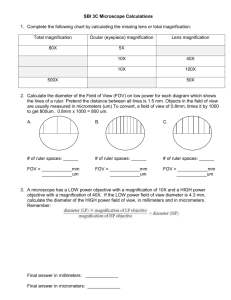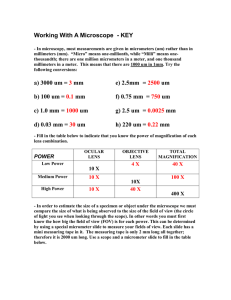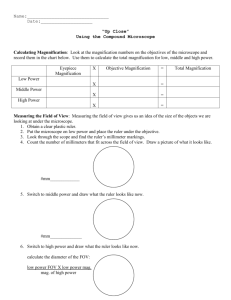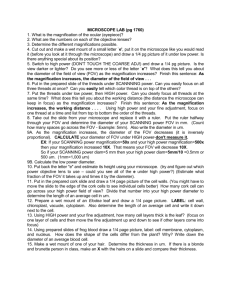Mrs. Gesualdo – Honors Biology – Lab 1
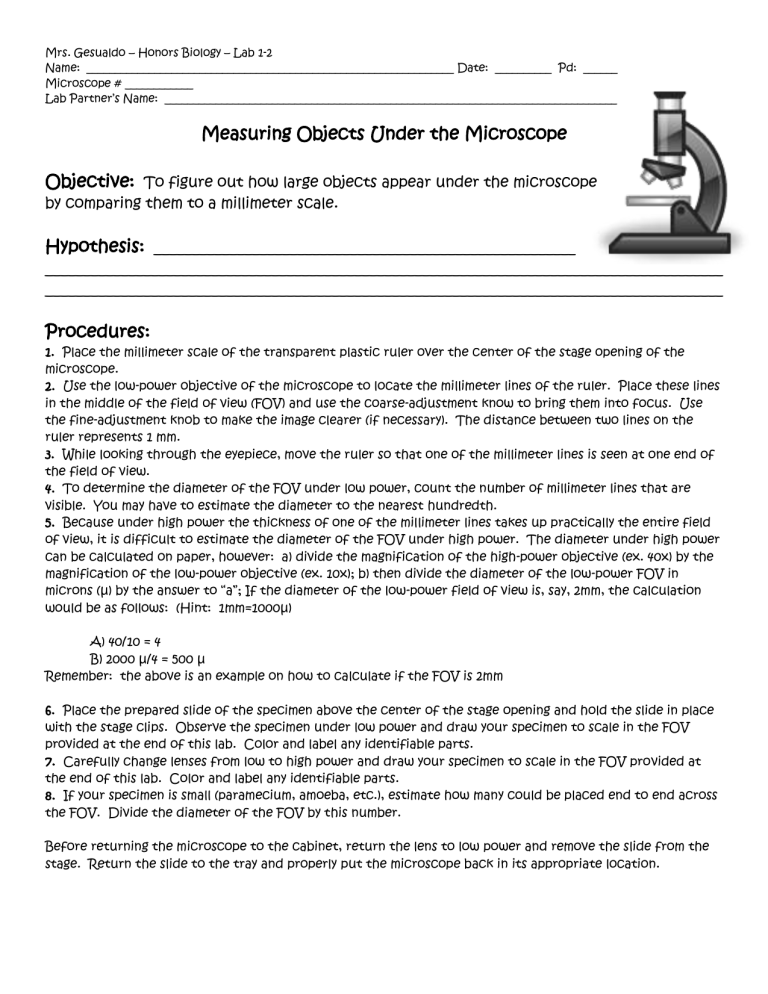
Mrs. Gesualdo – Honors Biology – Lab 1-2
Name: _________________________________________________________________ Date: __________ Pd: ______
Microscope # ____________
Lab Partner’s Name: ________________________________________________________________________________
Measuring Objects Under the Microscope
Objective:
To figure out how large objects appear under the microscope by comparing them to a millimeter scale.
Hypothesis:
________________________________________________________
__________________________________________________________________________________________
__________________________________________________________________________________________
Procedures:
1. Place the millimeter scale of the transparent plastic ruler over the center of the stage opening of the microscope.
2. Use the low-power objective of the microscope to locate the millimeter lines of the ruler. Place these lines in the middle of the field of view (FOV) and use the coarse-adjustment know to bring them into focus. Use the fine-adjustment knob to make the image clearer (if necessary). The distance between two lines on the ruler represents 1 mm.
3. While looking through the eyepiece, move the ruler so that one of the millimeter lines is seen at one end of the field of view.
4. To determine the diameter of the FOV under low power, count the number of millimeter lines that are visible. You may have to estimate the diameter to the nearest hundredth.
5. Because under high power the thickness of one of the millimeter lines takes up practically the entire field of view, it is difficult to estimate the diameter of the FOV under high power. The diameter under high power can be calculated on paper, however: a) divide the magnification of the high-power objective (ex. 40x) by the magnification of the low-power objective (ex. 10x); b) then divide the diameter of the low-power FOV in microns (µ) by the answer to “a”; If the diameter of the low-power field of view is, say, 2mm, the calculation would be as follows: (Hint: 1mm=1000µ)
A) 40/10 = 4
B) 2000 µ/4 = 500 µ
Remember: the above is an example on how to calculate if the FOV is 2mm
6. Place the prepared slide of the specimen above the center of the stage opening and hold the slide in place with the stage clips. Observe the specimen under low power and draw your specimen to scale in the FOV provided at the end of this lab. Color and label any identifiable parts.
7. Carefully change lenses from low to high power and draw your specimen to scale in the FOV provided at the end of this lab. Color and label any identifiable parts.
8. If your specimen is small (paramecium, amoeba, etc.), estimate how many could be placed end to end across the FOV. Divide the diameter of the FOV by this number.
Before returning the microscope to the cabinet, return the lens to low power and remove the slide from the stage. Return the slide to the tray and properly put the microscope back in its appropriate location.
Calculations:
Drawings:
Specimen: ________________________________________________
Magnification: _____________
Specimen: ________________________________________________
Magnification: _____________
For the following questions, type up the questions and answers using 10 pt. Arial font, single-spaced
Analysis Questions:
1. What is the magnification of the eyepiece?
2. What is the magnification of your low power objective lens?
3. What is the magnification of your high power objective lens?
4. Show how you would calculate the total magnification of an object under low power using your microscope:
5. Show how you would calculate the total magnification of an object under high power using your microscope:
6. Describe IN DETAIL the step-by-step process of locating an object under the low power objective lens
(begin from retrieving the microscope from the cabinet and end with viewing the object on low power).
7. Describe IN DETAIL the step-by-step process from switching from low power to high power.
8. What is the diameter of the FOV under low power in millimeters?
9. How many microns (µ) are there in your low-power FOV?
10. When observing your specimen under low power, what happens when you move the slide left? Down?
11. Why do you think it is important to have a very thin specimen when using a light microscope?
12. Why is it important to use the low power objective before the high power objective?
